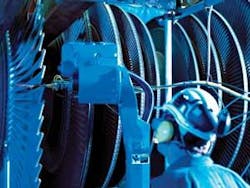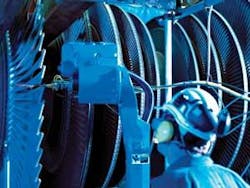Laser/robot repairs turbine rotor blades in situ
Adelaide, Australia - A new laser welding technique is repairing power station turbine rotor blades in minutes-rather than days-through advances in the way repair metals stick together. Called In Situ Laser Surfacing, the development is the product of a collective effort by several research institutions and power station operators.
As the name implies, In Situ Laser Surfacing allows flaws from wet steam erosion on the blades of low-pressure steam turbines to be repaired in place-without the need for the turbine to be dismantled and the blades removed.
Some power station operators have reported that current blade repair, or replacement, costs $AU250,000 per turbine per day in downtime-or up to $AU2.5 million in total per turbine. A typical low-pressure steam turbine rotor has 180 last-row blades, each about one meter long, with a replacement cost of $AU10,000 each if they cannot be repaired to the level of their original aerodynamic precision.
Dr. Nazmul Alam from Australia’s Commonwealth Scientific and Industrial Research Organization (CSIRO) explains that the new method uses high-power laser energy to fuse a metal alloy powder to the turbine blade’s surface. “And the work can be done without the need to deblade the rotor. It only has to be removed from its casing,” he says. “The laser is a portable unit that is taken to the power station, and the operation is performed by a robotic arm.”
Alam says the process is technically not welding. “The laser supplies a high-energy stream into which a metal alloy powder is directed. The laser fuses the metal to the blade’s surface,” he explains. Alum says conventional repair methods have used TIG welding, but the heat is difficult to regulate and blades can suffer thermal damage.
The technology has been in trial at TRUenergy’s Torrens Island power station in Adelaide, Australia. TRUenergy’s Asset Strategy Manager Ralph Villarosa says the initial field trial last year on six blades was successful and the company has just completed a second trial on a further 17 blades. He says the technique has significant commercial application.
For more information, visit www.csiro.au.

